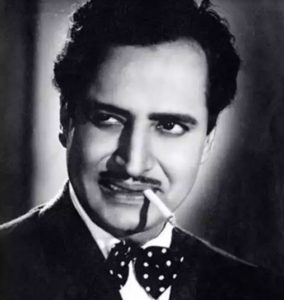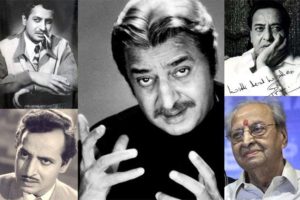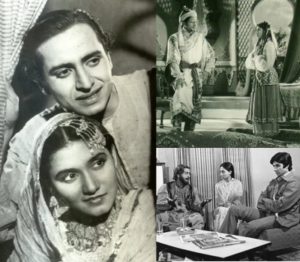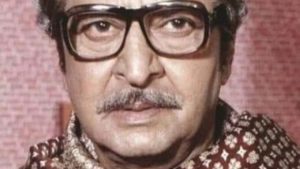By Vikas Datta
 When he passed away in 2013, the centenary year of Indian cinema, Pran had been acting for well over two-thirds of his 93 years, beginning as hero and ending up as a supporting actor – but making his mark in a long stint as such a convincing and consummate villain that Indian parents did not use his name for their children for at least a quarter of a century!
When he passed away in 2013, the centenary year of Indian cinema, Pran had been acting for well over two-thirds of his 93 years, beginning as hero and ending up as a supporting actor – but making his mark in a long stint as such a convincing and consummate villain that Indian parents did not use his name for their children for at least a quarter of a century!
He did not need any appurtenances to portray his evil nature onscreen – just a glare from his remarkable eyes, along with his steely voice, and a sneer – were enough.
Pran, however, sought to imbue each performance – whether as villain or supporting actor – with something different, be it mannerisms, make-up, and proper accents. Remember his outings as a Pathan, a Nepali, a Bhopali, and a Goan, or the ones in which he modelled his appearance on Sheikh Mujibur Rehman, Abraham Lincoln, or Sam Pitroda?
Born on February 12 in Delhi in 1920, Pran may not have been a “method actor” but he had natural talent and acute powers of observation of different types of people that he artfully incorporated into his performances.
 In the process, he transformed the Hindi film villain from a stereotype to a well-delineated character, who did not even require the willing suspension of disbelief needed for most cinematic performances.
In the process, he transformed the Hindi film villain from a stereotype to a well-delineated character, who did not even require the willing suspension of disbelief needed for most cinematic performances.
In his case, his fame was balanced by public abuse, children hiding from him, suspicion of most of his female co-workers (initially at least!), and the avoidance of the use of his name as his Allahabad University fans researched and informed him.
Son of a prosperous government civil contractor Kewal Krishan Sikand, Pran Krishan Sikand did not seem destined for a film career.
With a mobile childhood, studying in schools from Lahore to Unnao as his father moved to various places for his work, he was average in studies. So when his father asked him about his career choice, Pran, who was rather interested in photography, asked him to arrange his apprenticeship with a leading Delhi photo studio – whose proprietor was his father’s friend. Pran proved good at his work – so much that when the business expanded to Lahore, he was posted there.
And this paved for his most filmi entry into films. Once in Shimla, he had acted as Sita in Ram Leela, with Madan Puri as Ram, but that was it and neither was he interested in acting. However, a fortuitous encounter at a Lahore shop changed all that.
A man, who was sizing him up, approaching the then 19-year-old, said he was film writer Wali Mohammad Wali and the way Pran had eaten the pan had impressed him. He asked him to come to famous producer Dalsukh Pancholi’s office the next day to test for a role.
Pran thought the offer had been made to him when Wali was inebriated, so he did not keep the appointment. As fate would have it, he went to the cinema the next Saturday and ran into Wali, who walked across and “began abusing me with choice Punjabi invectives” for ditching him, he recounted later. A sheepish Pran apologised and promised to come, but Wali noted his address and came himself to pick him up.
 Pran debuted as a villain in ‘Yamla Jat’ (Punjabi, 1940) where Noor Jehan was the female lead. He did another couple of Punjabi films before the studio cast him as hero in its first Hindi film ‘Khandan” (1942) – again opposite Noor Jehan. He did two dozen-odd films till Partition – mostly as a hero, though he later confessed that he did not like being a hero because it involved singing songs and chasing heroines around trees!
Pran debuted as a villain in ‘Yamla Jat’ (Punjabi, 1940) where Noor Jehan was the female lead. He did another couple of Punjabi films before the studio cast him as hero in its first Hindi film ‘Khandan” (1942) – again opposite Noor Jehan. He did two dozen-odd films till Partition – mostly as a hero, though he later confessed that he did not like being a hero because it involved singing songs and chasing heroines around trees!
Partition put the brakes on his first stint, and he, having married and had a son, was lucky to be in Indore from August 1947, just as violence engulfed Lahore – having come to attend his son’s first birthday. The family moved to Bombay, but he failed to find any work and in process, they moved from the Taj Mahal Hotel, to a string of cheaper hotels, and ultimately, a guest house as their funds dwindled.
As he looked for work, he faced rejection after rejection and even intervention by friends like actor Shyam and writer Sadat Hasan ‘Manto’ was of no avail. However, in early 1948, his fate turned with Bombay Talkies offering him the villain’s role in ‘Ziddi’ (1949) – which also launched Dev Anand’s career as a hero.
Offers started pouring in and his career was on a roll again – and continued till he himself called off his screen appearances in the late 1990s due to growing age and health issues. During this, one of his signal contributions was getting Amitabh Bachchan his break in ‘Zanjeer’ (1973) as he and Ajit managed to convince the director.
Among Pran’s varied roles, those as Dilip Kumar’s tormentor in films like ‘Madhumati’ (1958), ‘Dil Diya Dard Liya’ (1966), ‘Ram Aur Shyam’ (1967) and then again in ‘Duniya’ (1984), Raj Kapoor’s near nemesis in “Jis Desh Mein Ganga Behti Hain” (1959) — where his rubbing of neck was to portray the dacoit’s fear of the noose, Amitabh’s benefactor in ‘Zanjeer’ (1973), ‘Majboor’ (1974), reluctant ally in ‘Don’ (1978) and ‘Kaalia’ (1981), and then, father in ‘Amar Akbar Anthony’ (1977), ‘Naseeb’ (1981) and ‘Sharaabi’ (1984), are the best known.
But, his role as the magician in fantasy ‘Alif Laila’ (1953), the title role in costumed drama ‘Halaku’ (1956), where he played Genghis Khan’s grandson with panache, his first outing as a Pathan in ‘Chhalia’ (1960), as a misogynistic professor and his effeminate nephew in rom-com ‘Jangal Mein Mangal’ (1972), his romp with Ashok Kumar in ‘Victoria No 203’ (1972), and the dacoit-turned-Lakhnavi Nawab in ‘Dharma’ (1973) are also worth being seen.
 Roles of the unrepentant dacoit in Manoj Kumar’s ‘Shaheed’ (1965) and then of Malang Chacha in ‘Upkar’ (1967) paved way for more positive characters. And though he did occasionally return as villain, Pran had a positive role in Raj Kapoor’s ‘Aah’ (1953) – this was attributed as a factor for it flopping! – and a hero in the comedy ‘Pilpili Saheb’ (1954).
Roles of the unrepentant dacoit in Manoj Kumar’s ‘Shaheed’ (1965) and then of Malang Chacha in ‘Upkar’ (1967) paved way for more positive characters. And though he did occasionally return as villain, Pran had a positive role in Raj Kapoor’s ‘Aah’ (1953) – this was attributed as a factor for it flopping! – and a hero in the comedy ‘Pilpili Saheb’ (1954).
While there are many more fascinating facts about Pran on and off screen, including his love for sports, there are three which need to be told.
He once turned down a Filmfare Award to protest a deserving candidate being left out in another category; he was a prime driver for a fund to support distressed film artistes and technicians, and he was one of the few Bollywood figures who publicly criticised the Emergency.
In the process, Pran proved that he didn’t need to play the hero to be one. (IANs)



